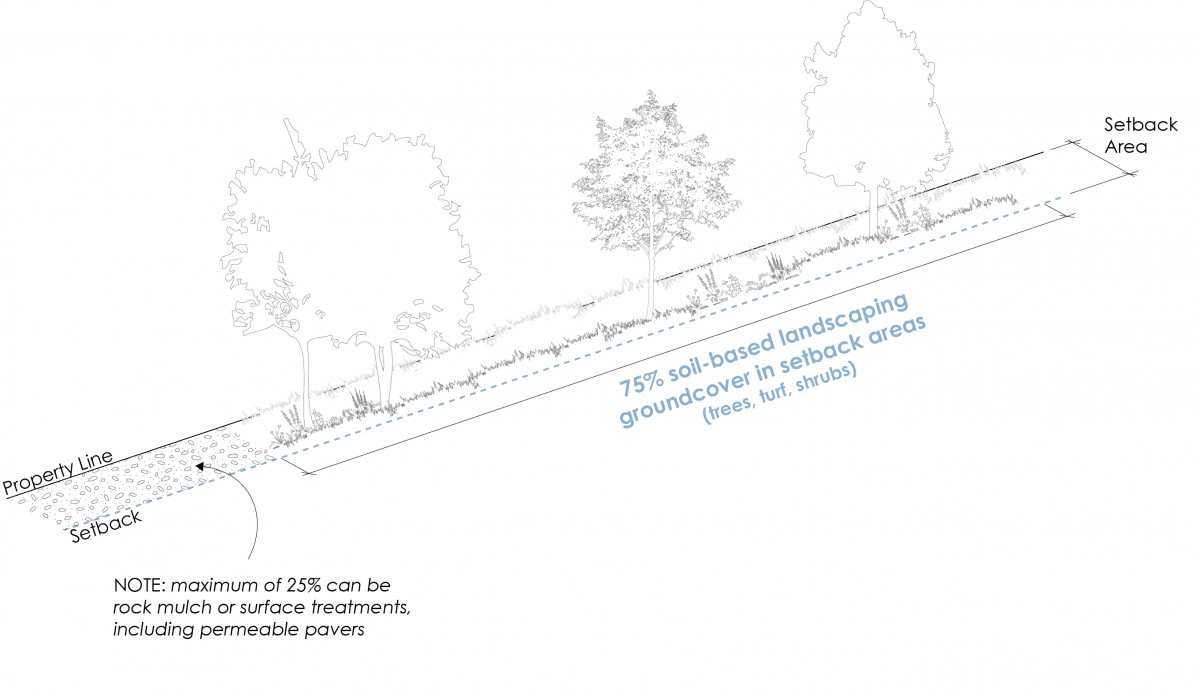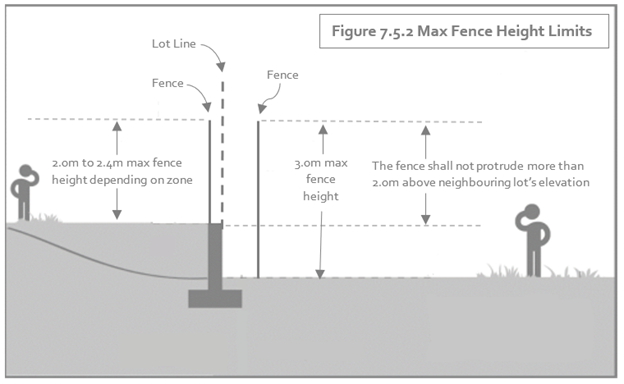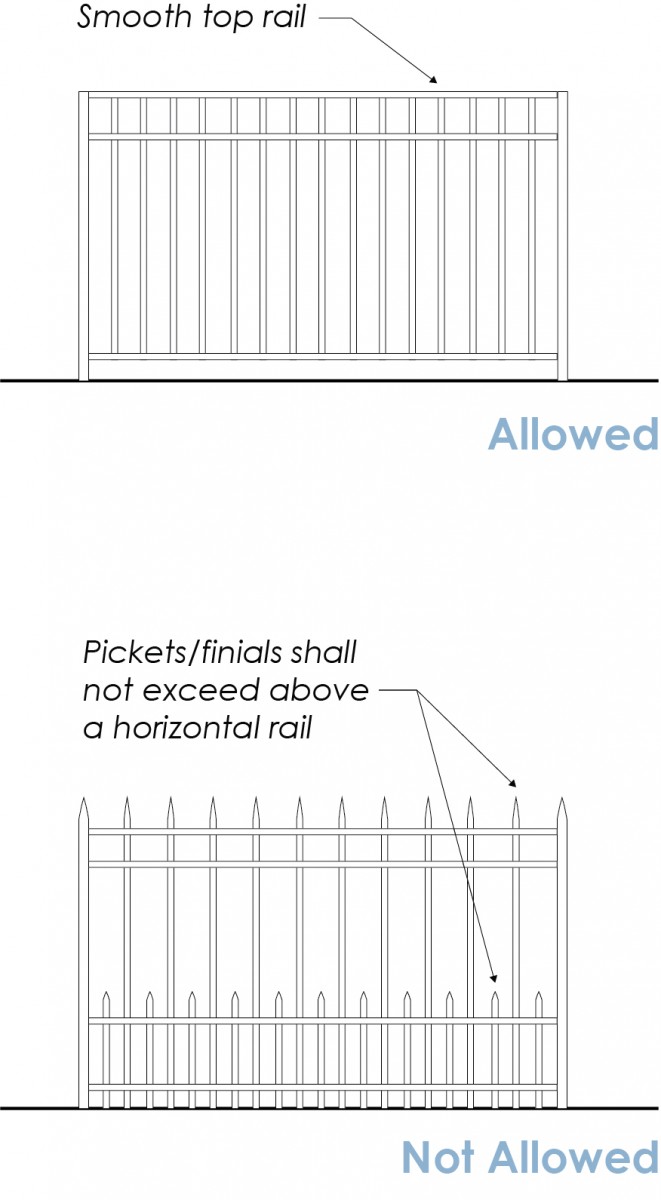Zoning Bylaw No. 12375
Section 7 - Site Layout

7.1.1 The intent of these landscaping and screening regulations is to contribute to a reasonable standard of livability, aesthetic, and placement of the landscaping, to provide for the masking and separating of various land uses.
7.2.1 All required landscape areas and installations including irrigation requirements shall meet or exceed the Canadian Landscape Standard (CLS) as jointly published by the Canadian Society of Landscape Architects and the Canadian Nursery Landscape Association.
7.2.2 All required landscape areas and installations shall be regularly maintained by property owners to meet or exceed the Canadian Landscape Standard.
- the landscape maintenance requirements shall address/provide for the following items regarding plant material: watering, mulching, pruning, fertilizing, liming and tree support as well as weed, pest, and disease control.
- the landscape maintenance requirements shall address/provide for the following items regarding lawns and grass areas: watering, fertilizing, liming, mowing, trimming, edging, aeration and repairs (regrading, reseeding or resodding) as well as weed, insect, and disease control.
- the execution of the above-mentioned landscape maintenance requirements shall take place on a regular basis as to ensure a healthy, neat, and orderly appearance throughout the year.
7.2.3 Landscaping within the landscape areas shall follow the regulations within Table 7.2 to provide for the masking or separating of various land uses. See Section 8.2.2 for parking restrictions within the landscape areas.
7.2.4 All required setback areas shall be landscaped with various tree species in accordance with Table 7.2 to provide for the masking or separating of various land uses. The minimum number of trees is identified within Table 7.2. In addition to Table 7.2 and to provide appropriate masking and separating of various land uses, the following must also be adhered to:
- properties adjacent to ALR land must meet landscaping standards as outlined in the Farm Protection DP Guidelines as outlined in the City of Kelowna’s Official Community Plan.
- properties zoned A1 and A2 must meet landscaping standards as outlined in the Farm Protection DP Guidelines as outlined in the City of Kelowna’s Official Community Plan.
| Table 7.2 Tree & Landscaping Planting Requirements cm =centimetres / m = metres / m2 = square metres / m3 = metres cubed | |||||
| Criteria | Regulations | ||||
Standard Requirements for Minimum Trees, Soft landscaping, and Soil Volume for all Developments .1 | |||||
| Minimum Number of Trees within Landscape Areas .1 | 1 tree per 10 linear metres of landscape area | ||||
Minimum Soft Landscaping Area .2 | 75% of the landscape area shall be soft landscaping | ||||
| Minimum Soil Volume per Tree .3 | 75% soil-based landscaping groundcover in landscape areas .9 , .11 See Visual Example Figure 7.2.1 | 75% soil-based landscaping groundcover in landscape areas .9 See Visual Example Figure 7.2.1 | 75% soil-based landscaping groundcover in landscape areas .6 , .9 | ||
| Minimum Soil Volume per Tree .3 | Single Tree | Shared | |||
| Large Tree | 20 m3 | 15 m3 | |||
| Medium Tree | 18 m3 | 12 m3 | |||
| Small Tree | 15 m3 | 10 m3 | |||
Area specific modification to Trees, Soft landscaping, and Soil Volume Requirements | |||||
| Overhead Power Lines for any zone | The minimum number of trees in the front yard or flanking yard landscape area can be planted outside the front yard or flanking yard landscape areas if the abutting: boulevard, front yard and / or flanking yard contains overhead electrical power lines that would interfere with the growth of the trees. | ||||
| Landscape Areas and Boulevards for Infill Housing | There is no minimum number of trees onsite and no minimum soft landscaping within the front yard or flanking yard landscape area if large trees are planted within the boulevard and the boulevard contains a sidewalk or a sidewalk is installed. | ||||
| Landscape Areas and Boulevards for any: MF2, MF3, MF4 .4 zone or any zone within Section 14 Core Area and Other Zones | The minimum number of trees can be planted outside of the front yard or flanking yard landscape areas if the abutting boulevard is irrigated and contains a sidewalk or a sidewalk will be installed. There is no minimum soft landscaping required within the front yard or flanking yard landscape area if the minimum number of trees is planted outside the front yard or flanking yard landscape area. | ||||
| Universal Landscape Requirements | |||||
| Minimum Landscaping for any surface parking lot over 15 vehicles .5 | (a) If a surface parking lot contains 15 vehicles or greater and abuts a street, then the interface area with the street must have a minimum 1.5 metres landscape area. | ||||
| Minimum / Maximum Tree Spacing | Minimum tree spacing is based on site requirements for sightlines or accessibility along with standard planting practices for the tree species. Trees may be planted closer together as needed and additional trees are highly encouraged. Spacing is not dictated by requirements for the number of trees required in the Landscape Area. | ||||
| Minimum Setback from buildings, raised patios, and balconies to on-site trees | Large: 3 m radius from centre of tree to the building Any underground parkade, underground building, underground structure (such as a stormwater detention tank) must be setback at least 1 metre volumetrically measured from the centre of the tree at finished grade (trunk flare). | ||||
| Minimum Deciduous Tree Planting Stock Caliper .1 | Large: 5 cm | ||||
| Minimum Coniferous Tree Planting Stock Height | 250 cm | ||||
| Minimum Ratio between Tree size .7 | Large: Min 50% | ||||
FOOTNOTES (Section 7.2): | |||||
| Figure 7.2.1 - Visual Example of Soil-Based Landscaping |
 |
7.2.5 Notwithstanding any other provisions in this Bylaw, wherever Environmentally Sensitive Areas (as defined in the OCP) or Natural Hazard Areas (as defined in the OCP) are located, then the land and vegetation shall remain undisturbed or be restored (as described in the OCP). Riparian Management Areas (as defined by the OCP) must remain in its natural condition or be restored in a manner that either enhances conditions for fish and wildlife or maintains conditions equivalent to those that would have existed had no development occurred.
7.2.6 All construction on-site must occur concurrently with erosion control and protection measures to prevent the pollution, degradation, or siltation of natural areas, including vegetation and water courses. This includes the provision of temporary fencing prior to and during construction.
7.2.7 Unless part of a Natural Hazard or Environmentally Sensitive Area (as defined by the OCP), landscape areas will be graded to maintain safe access according to the Canadian Landscape Standards (CLS), for efficient maintenance, and to collect storm water for plant watering where City stormwater regulations allow.
7.2.8 All landscape areas shall be watered by a fully automatic irrigation system. No run-off onto sidewalks, streets, or parking areas shall be permitted. The following areas are exempt from having permanent fully automatic irrigation systems:
- existing areas of undisturbed native vegetation which have been accepted as landscape area or Riparian Management Area;
- landscape areas specifically designed as xeriscape or drought resistant natural species plantings; however, temporary irrigation may be required;
7.2.9 Where the retention of trees and ground cover is required or permitted, a letter from a qualified professional, such as a certified arborist or Landscape Architect, shall be submitted, indicating the mitigation measures required during and after the construction to ensure the health of the vegetation.
7.2.10 [Deleted]
Private Collection
7.3.1 All refuse and recycling bins (including all other large receptacles used for the temporary storage of materials) that are placed wholly above natural grade (in zones other than agricultural zones) shall:
- require opaque screening from adjacent lots and streets.
- all screening shall be a minimum of 1.3 metres in height to a maximum height that is equivalent to the height of the refuse or recycling bin.
- all sides open to public view shall be screened by the additional planting of shrub and groundcover material at least 1.5 metres in height.
- all refuse or recycling bins shall be setback a minimum of 3.0 metres from any lot line abutting a rural residential, single & two dwelling, or multi-dwelling zone.
- an unobstructed access lane with a minimum width of 3.0 metres and a minimum vertical clearance of 4.6 m shall be provided to provide access to a required garbage and recycling room or enclosure.
7.3.2 All refuse and recycling bins that are placed in-ground must be set back 0.5 metres from a front lot line or side lot line.
Public Collection
7.3.3 All garbage, yard waste, and recycling containers must be stored within a building, enclosure, or a garage. The space allocated per bin must meet the dimensions shown in Table 7.3.3 Minimum Refuse and Recycling Bin Space.
Table 7.3.3 Minimum Refuse and Recycling Bins Space | ||||
| Container Size: | Min. Cart Length (m) | Min. Cart Width (m) | Min. Cart Height (m) | Min. Cart Aisle Width .1 |
| 120 litre Cart | 0.6 m | 0.5 m | 1.8 m | 0.6 m |
| 240 litre Cart | 0.7 m | 0.6 m | 1.9 m | 0.7 m |
| 360 litre Cart | 0.9 m | 0.7 m | 2.0 m | 0.8 m |
FOOTNOTES (Table 7.3.3): | ||||
7.4.1 Urban plazas are a screening or masking site design element required to separate adjacent uses when large building frontages are proposed.
7.4.2 The minimum plaza street frontage is 7.5 metres.
7.4.3 The minimum plaza depth is 6.0 metres. Urban plazas must have a minimum of one tree, with a minimum 90 millimetre caliper and rootball of 900 millimetres.
7.5.1 Screening fences shall be opaque double-sided construction. Where screening fences are allowed or required by this Bylaw, they shall be of an opaque or a combination of opaque and lattice design.
7.5.2 The maximum height for fences constructed from natural grade shall be:
- 2.0 metres in rural residential zoned properties except; where abutting an agricultural, industrial, or commercial zone commercial zone, then the maximum height shall be 2.4 metres.
- 2.0 metres in suburban residential, multi-dwelling, village centre, or urban centre zoned lots except; that it shall not exceed 1.2 metres in height within the minimum front yard or flanking yard setbacks.
- 2.4 metres in commercial, public and institutional, or industrial zoned properties.
Notwithstanding S.7.5.2 (a), (b), & (c); the maximum height of a fence that abuts a neighbouring lot which is higher in elevation and is erected on the low side is 3.0 metres, as long as, the fence does not protrude more than 2.0 metres above the elevation of the neighbouring lot (see Figure 7.5.2)

7.5.3 Lots in industrial zones are to have an opaque 2.4 metres high fence around all storage yards, along all lot lines abutting non-industrial zones and around wrecking yards that are visible from a street abutting the lot.
7.5.4 No metal fence shall be constructed or erected that have the ends of the fence pickets or finials extend above a horizontal rail (see Figure 7.5.4).
| Figure 7.5.4 - Fencing Types |
 |
7.5.5 No barbed wire fencing shall be constructed or erected in any rural residential, suburban residential, multi-dwelling, or core area & other zone, except in the P1 zone where the site is used for detention and correction services.
7.5.6 No razor wire fences shall be constructed or erected in any zone except were associated with penitentiaries, jails, or places of incarceration.
7.5.7 No fencing shall be constructed or erected at or below the high-water mark (geodetic elevation of 343 metres) of Okanagan Lake.
7.6.1 No individual retaining wall shall exceed a height of 1.2 metres measured from grade on the lower side.
- Except, where the grade of the subject lot is lower than the abutting property then any retaining walls must not exceed a height of 3.0 metres measured from grade on the lower side.
- Except, retaining walls can be any height subject to condition of subdivision approval.
7.6.2 Notwithstanding S.7.6.1; any individual retaining wall greater than 1.2 metres in height must be constructed with a professional design by a qualified professional engineer.
7.6.3 Notwithstanding S.7.6.1; any tiered retaining walls must be spaced horizontally a minimum of 1.2 metres between tiers. The maximum number of tiers that may be constructed without a professional design by a qualified professional engineer is two. The maximum total height of any retaining wall system that may be constructed without a professional design by a qualified professional engineer is 2.4 metres.




